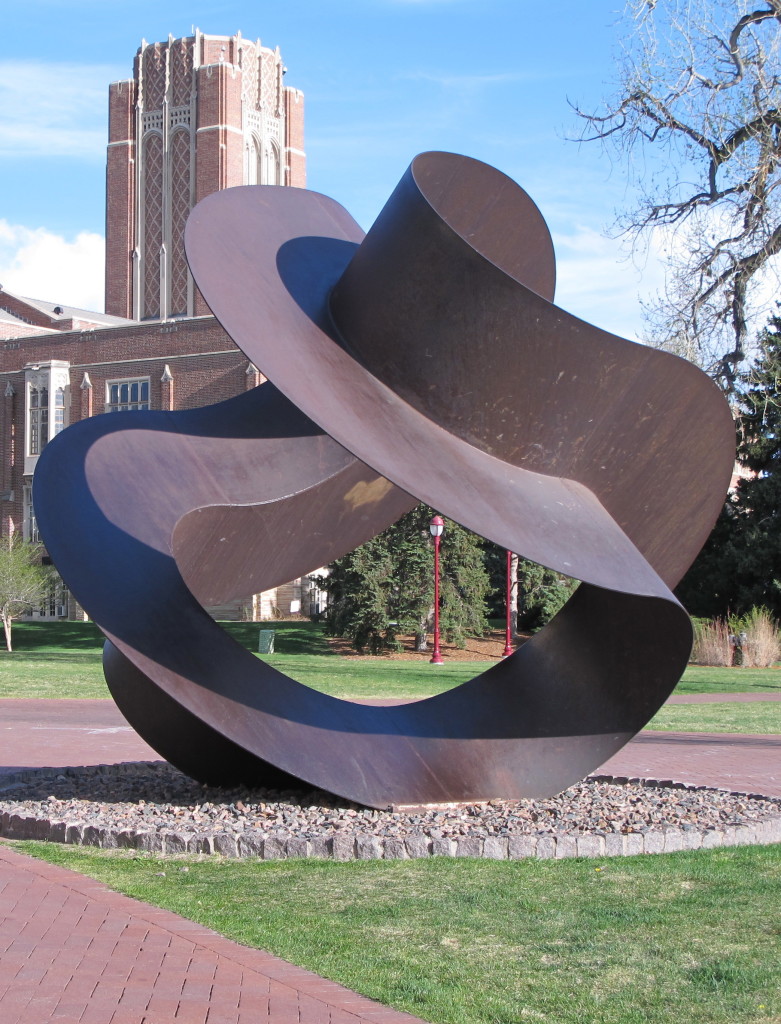Bullet Proof Campus Art: Humor

Charles O. Perry, Bullet Proof Campus Art, 1973
Location: Outside Anderson Academic Commons, Southwest Corner
Charles O. Perry’s 1973 abstract sculpture celebrates independence of thought and a slightly rebellious spirit on the part of two creative artists. The sculpture by Perry (1929-2011) was strongly recommended by Gyo Obata (b.1923), principal architect of the 1972 Penrose Library. Obata wrote to Perry, asking him to design a “bullet-proof” sculpture that would stand up to unruly students, explaining that DU required this assurance (in May of 1970, students had occupied the current site of Penrose Library during the “Woodstock West” anti-war protest).
Perry responded with a design for a sculpture in his signature geometric style, titled Bullet Proof Campus Art. Obata wanted the piece to complete the library’s main entrance, but DU would not provide the funds. The architect bought the sculpture himself and donated it to the University. Perry and Obata may have better understood the value of going outside the “comfort zone” than the University administration of the time. Bullet Proof Campus Art is a popular work, and one of the few elements of Obata’s modernist vision to seem truly at home on the campus.
Click HERE to return to the Campus Art Highlights page
View Living Memory DU in a larger map
—–
DU Art! Art Walk Training:
STOP: Anderson Academic Commons (5 MINUTES)
Charles O. Perry, Bullet Proof Campus Art, 1973. Donated by Gyo Obata, Penrose architect
Location: Outside, Southwest Corner
- This piece illustrates how the relationship between the university and student body had evolved between 1929 and 1973. In May 1970, students at the University of Denver organized protests, fueled by elevation of the war in Vietnam and the shootings at Kent State. The students decided to take their protest to Carnegie Lawn (now the site of the Penrose Library). They began building what came to be known as “Woodstock West,” a series of tents and crudely made shelters that formed an instant community for the discontented.
- When the architect of Penrose Library, Gyo Obata, commissioned this piece, he specifically asked for something “bullet proof” that students would not be able to hurt, and so Perry titled it Bullet Proof Campus Art.
- The 1970s were also when the engineering students created their sculpture at Boettcher.
- Obata was dedicated to the idea that the furnishings and art inside a building should complement its design. When he built Penrose he was relatively unknown, but would later go on to found the HOK architecture firm that was responsible for the construction of Camden Yards and later Coors Field.
- Obata wanted a sculpture by Perry who epitomized the international style, and created geometric puzzles and jewelry in addition to his sculptures. However, DU refused to pay for the piece, so Obata stepped in and purchased the sculpture himself.
- It was originally placed directly in front of the entry to the library, and was later moved to the corner.
- Since 1964, Perry has concentrated on large scale public sculpture, the most prestigious of which stands in front of the National Air and Space Museum, in Washington, D.C. The piece, “Continuum”, began as an exploration of the Mobius strip, a product of pure mathematics formed by joining two ends of a strip of paper after giving one end a 180 degree twist, thus creating only one edge. Inside Penrose there is a painting entitled Triple Mobius by current DU professor of painting Deborah Howard. Deborah wanted to place the mobius inside the context of a library because she felt that research is also an infinite exploration.
- As the university continues to expand its public art program, today we work to integrate new pieces that fit within the original intentions of earlier artists and designers. Much like the mobius, our community and our art is in a continuous evolution.
